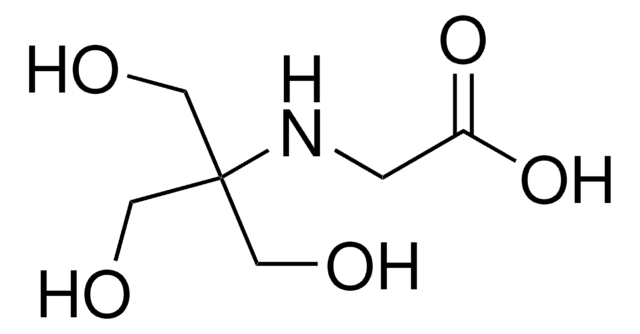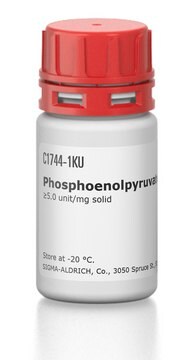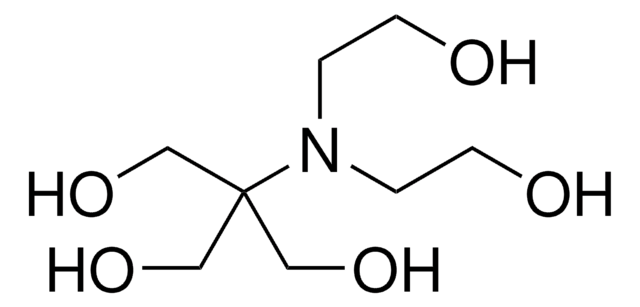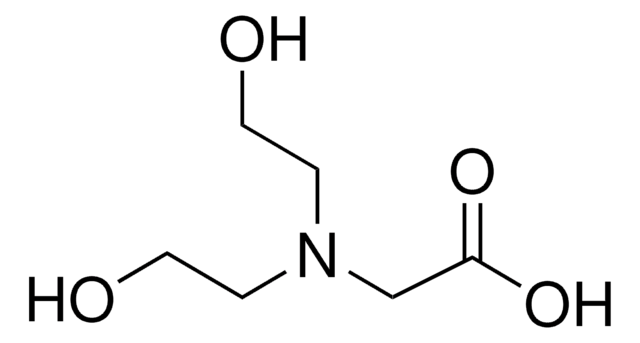모든 사진(2)
About This Item
Linear Formula:
(HOCH2)3CNHCH2CO2H
CAS Number:
Molecular Weight:
179.17
Beilstein:
1937804
EC Number:
MDL number:
UNSPSC 코드:
12161700
NACRES:
NA.21
추천 제품
생물학적 소스
synthetic
Quality Level
양식
powder
기술
cell culture | mammalian: suitable
불순물
Endotoxin, microbial, and trace metals; tested
유용한 pH 범위
7.4-8.8
pKa(25 °C)
8.1
적합성
suitable for manufacturing use
외래 활성
Cytotoxicity, DNase, NICKase, RNase, and Protease; tested
SMILES string
OCC(CO)(CO)NCC(O)=O
InChI
1S/C6H13NO5/c8-2-6(3-9,4-10)7-1-5(11)12/h7-10H,1-4H2,(H,11,12)
InChI key
SEQKRHFRPICQDD-UHFFFAOYSA-N
유사한 제품을 찾으십니까? 방문 제품 비교 안내
일반 설명
Our SAFC® portfolio of high-quality raw materials for use in biopharmaceutical processing withstands strict quality control procedures plus the documentation and expertise to help our customers meet requirements as defined by the M-Clarity Program.
M-Clarity Program
Buffer quality is vital for the success of biopharmaceutical processes, because buffers are indispensable in nearly every production step.
Our broad portfolio of buffer materials manufactured under appropriate controls is tailored to your needs. Ranging from non-GMP grades for low-risk application, to IPEC-PQG GMP for higher-risk applications, we have products covering all your manufacturing needs.
M-Clarity Program
Buffer quality is vital for the success of biopharmaceutical processes, because buffers are indispensable in nearly every production step.
Our broad portfolio of buffer materials manufactured under appropriate controls is tailored to your needs. Ranging from non-GMP grades for low-risk application, to IPEC-PQG GMP for higher-risk applications, we have products covering all your manufacturing needs.
애플리케이션
Buffer component for separation of low molecular weight peptides.
Tricine is a biological buffer often referred to as a “Good′s” buffer. The pKa of Tricine is 8.1 which makes Tricine is a good candidate for biological applications that require pH control above physiological. Tricine is considered to be non-toxic to culture cell lines, highly water soluble and provides high-solution clarity.
Tricine can be used in a wide array of biological applications including as a component in media formulations. Specific applications include buffers for electrophoresis, protein purification and diagnostic reagent production.
Tricine can be used in a wide array of biological applications including as a component in media formulations. Specific applications include buffers for electrophoresis, protein purification and diagnostic reagent production.
포장
Product is available in the following package sizes:
RES3077T-A701X: 100 gm container
RES3077T-A702X: 1 kg container
RES3077T-A704X: 10 kg container
RES3077T-A705X: 25 kg container
RES3077T-A701X: 100 gm container
RES3077T-A702X: 1 kg container
RES3077T-A704X: 10 kg container
RES3077T-A705X: 25 kg container
법적 정보
SAFC is a registered trademark of Merck KGaA, Darmstadt, Germany
교체됨
제품 번호
설명
가격
Storage Class Code
13 - Non Combustible Solids
WGK
WGK 3
Flash Point (°F)
Not applicable
Flash Point (°C)
Not applicable
이미 열람한 고객
Hermann Schägger
Nature protocols, 1(1), 16-22 (2007-04-05)
Tricine-SDS-PAGE is commonly used to separate proteins in the mass range 1-100 kDa. It is the preferred electrophoretic system for the resolution of proteins smaller than 30 kDa. The concentrations of acrylamide used in the gels are lower than in
Arpita Gantayet et al.
Biofouling, 29(1), 77-85 (2012-12-06)
The freshwater zebra mussel (Dreissena polymorpha) is a notorious biofouling organism. It adheres to a variety of substrata underwater by means of a proteinaceous structure called the byssus, which consists of a number of threads with adhesive plaques at the
Christian Nilsson et al.
Electrophoresis, 31(3), 459-464 (2010-02-02)
Totally porous lipid-based liquid crystalline nanoparticles were used as pseudostationary phase for capillary electroseparation with LIF detection of proteins at physiological conditions using unmodified cyclic olefin copolymer capillaries (Topas, 6.7 cm effective length). In the absence of nanoparticles, i.e. in
Thierry Rabilloud
Journal of proteomics, 73(8), 1562-1572 (2010-04-17)
Electrophoretic separations of proteins are widely used in proteomic analyses, and rely heavily on SDS electrophoresis. This mode of separation is almost exclusively used when a single dimension separation is performed, and generally represents the second dimension of two-dimensional separations.
Kriston Ganguli et al.
Pediatric research, 77(4), 528-535 (2015-01-13)
Bacterial contact in utero modulates fetal and neonatal immune responses. Maternal probiotic supplementation reduces the risk of immune-mediated disease in the infant. We investigated the immunomodulatory properties of live Lactobacillus rhamnosus GG and its SpaC pilus adhesin in human fetal
자사의 과학자팀은 생명 과학, 재료 과학, 화학 합성, 크로마토그래피, 분석 및 기타 많은 영역을 포함한 모든 과학 분야에 경험이 있습니다..
고객지원팀으로 연락바랍니다.






